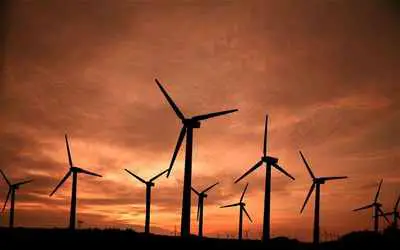Wind energy is a converted form of solar energy. Solar radiation heats different specific areas of land area, the most noticeable day to night. There are differences between how the absorption of solar radiation stretches of water to the land. These differences will translate into differential heating of the atmosphere. The temperature difference will cause movement of air masses and the result of this movement is the wind. Air mass set in motion contains kinetic energy. There are many advantages and disadvantages of wind energy which are described briefly below. You might also be interested to know about solar energy pros and cons here.
Advantages of Wind Energy
A wind turbine converts the kinetic energy of wind into electricity or mechanical form that can be used for practical use. Some turbines can produce five MW, so it requires a wind speed of about 5.5 m / s or 20 miles per hour. Few areas on earth have these wind speeds, but the strong winds can be found at higher elevations and oceanic areas. Most turbines generate more than 25% of the time, this percentage increases in winter, when the winds are stronger.
- The main advantage of wind energy is zero emissions of pollutants and greenhouse gases, because they do not burn fuel;
- No waste is produced. Wind energy production does not involve producing any waste;
- Lower cost per unit of energy produced. The cost of electricity in modern wind power plants decreased substantially in recent years. In 2004, the price of wind power has already reached one-fifth compared to that of the 80s, and are forecast to continue their decline;
- Reduced downtime-decommissioning costs. Unlike nuclear power plants, for example, where decommissioning costs may be several times bigger, than the cost of the plant, in the case of wind generators, decommissioning costs at the end of the normal operating period, are minimal; they can be fully recycled.

Disadvantages of Wind Energy
Some of the earliest Egyptian inscriptions attest to the fact that in IV BC, they were the ones who discovered and used this form of energy. The Egyptians invented canvas for browsing and boats moved with the wind, the first way of using wind energy. Chinese people were he who invented the windmill.
- At first, an important disadvantage of wind power production was quite high production cost and relatively low reliability of the turbines. In recent years however, the production cost per unit of electricity fell sharply, reaching figures of the order 3-4 cents per kilowatt-hour by improving the technical parameters of the turbines;
- Another disadvantage is the “visual pollution” – that is, have a bad appearance – and produce “noise pollution” (too noisy). Others argue that the turbines affect the environment and surrounding ecosystems, killing birds and requiring large vacant land for their installation. The argument against them is that modern wind turbines have a stylized attractive appearance, that cars kill more birds than wind turbines per year and that other sources of energy such as electricity generation using coal, are much more harmful to the environment because it creates pollution and produce the greenhouse effect;
- A practical disadvantage is the variation in wind speed. Many places on Earth cannot produce enough electricity using wind power;
- High risk of damage when storms, if the wind speed exceeds the design limits. No matter how great the allowed limit, there is always the possibility that it will be exceeded.
In conclusion, wind energy represents a real alternative for creating electricity. Electricity produced by wind kinetic motion capture is environmental friendly. The advantages and disadvantages of using wind recommend using this type of energy.
